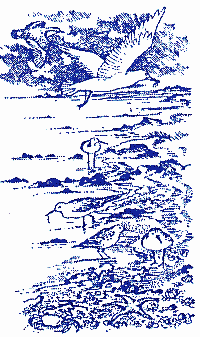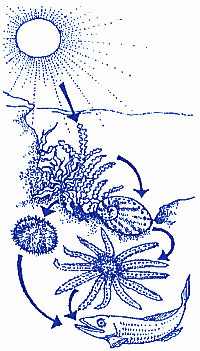|
Following are a selection of activities for schools to engage in exploring Jewels of the Sea and Celebrating Australia's Marine Biodiversity.
Activities are given for each of the Key Learning Areas. Activities can be adapted by teachers to suit local environments and meet a range of learning outcomes at different levels in the National Profiles.
Health & Physical Education
Have all students form a circle to represent an intact or undisturbed marine environment. Explain each person is like an individual part of the environment and the animals and plants that together make up a marine ecosystem. Have the students turn to the right and place their hands on the shoulders of the person in front. On the count of 1, 2, 3 . . all students immediately sit down on the persons knees behind them and hold. Find out what happens when a single part of the system is removed.
Have students investigate their local shops to find at least ten different items from the sea that are used for food or added to food. What other foods from the sea are eaten in different cultures?
Studies of Society and Environment (SOSE)
Investigate coastal or marine animals or plants that are rare or threatened in your state or region. What plans are in place to assist in their recovery?
Investigate the history of marine animals in the fossils found in your area. Much of Australia, including the central desert regions, has been under the sea at various times in history. Examine some limestone for fossils using a magnifying glass. Identify the fossils present, find out where they came from, how old they are and what they looked like when they were alive. Are animals found as fossils still alive today? Present a report on your findings.
 |
With a map of Australia find your closest ocean. Follow creeks and rivers. Tell the story of a drop of rain from your roof on its incredible journey to the ocean.
With a map of Australia mark in all the existing Marine National Parks and the type of biodiversity it is conserving. In a different colour mark in places where parks are proposed. In third colour mark where you think there should be a marine park and why.
Write and design an advertisement to promote the amazing marine biodiversity of your state or region.
Interview students, staff and older people about a local coastal or marine environment eg a beach or a park. Discover the changes over the years and the impacts on the area. Write a radio report. |
Science
|
Investigate what marine animals and plants are found in your local area or state. Are any of these animals or plants only found locally or in your region? Are any species threatened by changes to the environment?
Collect information about some of the amazing plants and animals of our oceans. Create a set of cards with clues on the back and a sketch on the front. What games can you play?
Do a beachcomb for seaweeds and other marine plants. Find how many different types are found on your local beaches. You can make a collection of local seaweeds by carefully arranging seaweeds onto sheets of paper and pressing them until they are dried.
Remember that many seaweeds contain lots of water and will need to have papers changed often to prevent them from going mouldy. Small seaweeds can be floated in water then lifted out onto pieces of card. When they are dry they can be kept in place by fixing with an adhesive spray. |
 |
Identify and compare a range of different features of marine animals eg, fins, eyes, gills, tail shapes, eggs, and body shapes. Show in a class presentation or report how different features are useful in assisting in survival in different environments or conditions.
Collect pictures of Australian marine animals and plants and use different strategies to classify them into different groups based on similarities and differences.
Examples of the major threats to biodiversity are habitat modification, pollution and poor management practices. Consequently many sea animals are in trouble. Research a sea animal, find out more about its habitat and the ecosystem it belongs to. Write a report card for the survival of this marine species.
Visit a marine or coastal environment and do a survey to find out about diversity in that area. Choose a particular group of animals or plants and write a report based on what you have found. Find out about threats to local biodiversity during your visit.
Next: What's in a name?
|